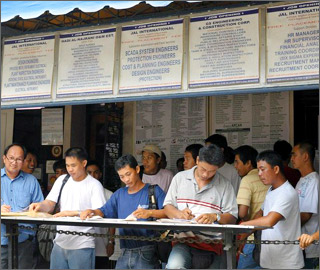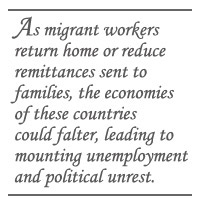Exporting People
Exporting People

NEW YORK: When a nation’s population becomes far larger than its domestic economy can readily accommodate, governments can either do nothing and allow poverty to set in or they can export people. That policy has worked for many countries. In 2008, nearly $300 billion were remitted to developing countries by immigrant labor.
But the global economic crisis which is hitting the developed countries hard might generate a tsunami-like wave of migrants returning home, and falling remittances hitting the developing nations even harder.
Many developing countries have found it attractive and profitable to facilitate the departure of workers and their families. By having their citizens work abroad, sending countries have the opportunity to gain valuable foreign exchange through remittances, reduce domestic unemployment and lessen poverty levels as well as diminish the risks of civil unrest.

Yet with the widening global economic slowdown, the strategy could backfire. Living conditions in labor-exporting countries will in all likelihood worsen. As unemployment rises in the labor-importing nations, governments will cut the number of foreign-worker permits, restricting family reunion visas and offering incentives, and in some cases disincentives, for unemployed foreigners to go home, especially those immigrant workers in the country unlawfully. Moreover, given the widespread public sentiment in Europe and the United States for lower levels of immigration even before the economic downturn, elected officials in these countries will face mounting pressures to substantially reduce numbers of foreign workers.
As migrant workers return home, or at least reduce the amount of remittances sent to their families, the economies of the labor-exporting countries are likely to falter, leading to mounting domestic unemployment and political unrest. Anticipating these possible troubling outcomes, some developing countries are taking steps, such as providing money to troubled industries to prevent layoffs and launching public-information campaigns, to mitigate expected social and political consequences of the economic slowdown and reduced remittance flows.
Illustrative of this demographic-development strategy and the pitfalls are the experiences of Mexico, Morocco and the Philippines.

At the beginning of the 20th century, the populations of Mexico, Morocco and the Philippines were relatively small, approximately 14 million, 4 million and 7 million, respectively. By the year 2000, the Mexican and Moroccan populations had increased about sevenfold to 100 million and 29 million, respectively, and the Philippine population increased tenfold to 76 million. By mid-century, the populations of Mexico, Morocco and the Philippines are expected to reach 132 million, 43 million and 140 million. And without further emigration, their populations in 2050 would be even larger than projected, 152 million, 46 million and 151 million, respectively (Figure 1).
Such rapid rates of population growth combined with shortcomings in the domestic labor market have led to approximately 10 percent of the Mexican, Moroccan and the Philippine populations residing and working aboard.
Perhaps the most advanced government program to promote overseas employment is in the Philippines, where the Philippine Overseas Employment Administration established more than a quarter century ago has become an integral part of the country’s Department of Labor and Employment. Mexico also has agencies to aid citizens working abroad, such as the Program for Mexican Communities Living Abroad. In addition, the government started a program known as "3x1" – for every $1 sent from a Mexican emigrant club or association for a development project in Mexico, the government contributes $3. In a similar vein, Morocco established in 1990 a ministry to aid its citizens working abroad as well as the "Fondation Hassan II pour les Marocains Résidant à l'étranger," which fosters links with Moroccan migrants.
In 2008 these overseas workers sent home remittances amounting to $24 billion, $7 billion and $17 billion dollars, respectively. Individual monetary remittances are the second largest source of foreign currency for Mexico after oil, and remittances are a major factor in the economies of Morocco and the Philippines, representing 10 percent and 14 percent of their respective GDPs.
If large numbers of their overseas workers were to return home, the three nations would face increased domestic unemployment and related economic hardships, possibly leading to civil instability and perhaps subsequent political upheaval. In addition, without the substantial inflows of remittances, millions of Mexican, Moroccan and Philippine families who have come to rely on this income would face significant declines in their living standards, with some joining the ranks of the impoverished underclass. Falling remittances would also likely have a rippling effect throughout the economies insofar as the monies are used primarily for consumption.

More broadly speaking, while the demand for labor in the wealthy industrialized regions has been sizeable, it remains far below the enormous supply of labor in the less developed regions. The imbalance is reflected by the fact that for every person of age to work, 15 to 64 years, in the more developed regions, there are four people in the less developed regions. In particular, as the domestic markets of African countries cannot absorb such large numbers of workers, many will turn to immigrating illegally to Europe.
Moreover, this demographic imbalance is widening. In the coming decades, population increases in the developing nations are projected to greatly surpass the expected population declines among developed countries. For example, whereas Europe’s current population is projected to decline by 67 million by mid-century, Africa’s population is expected to increase by an additional 1 billion during this period. Among the youth aged 15 to 24 years old, Africa is projected to gain an additional 165 million people compared to an expected decline of 34 million in Europe.
The large and widening demographic imbalance between the regions is exacerbated by the enormous socioeconomic differences in living conditions. In many parts of the developing world, especially in Africa and South Asia, populations already confront low pay, limited health care and few career opportunities, with life in rural areas being especially harsh. In addition, personal security is often lacking or inadequate for many.
Well before the current financial crisis began, tens of millions of men and women had resorted to illegal immigration. In response to these unauthorized flows, labor-receiving countries tightened borders and policies, instituted new guidelines and procedures, e.g., photos, fingerprints, lengthy detentions, deportations and immigration bans, signed agreements and other initiatives with other countries aimed at reducing illegal immigration flows.

Some months ago, for example, the European Union financed the establishment of the Centre for Migration Information and Management in Bamako, Mali, which serves a job center, a source of advice on legal ways of settling in Europe as well as counsel on the hazards of illegal migration. More recently, the United Nations and the European Union announced a €15 million joint initiative to promote legal migration, address life-threatening illegal flows and protect migrant workers during the current economic crisis.
Nonetheless, such efforts to confront illegal migration are likely to be too little and too late. The worsening global economy, the vast and widening differences in living standards, including political instability and insecurity, and the enormous demographic imbalances between richer and poorer regions are generating powerful migration forces. These forces exert tremendous pressures on millions of men and women in the developing world, especially the youth, to emigrate – illegally if necessary – to the wealthy industrialized nations. Against these formidable push-pull migration forces, warnings, information campaigns, bilateral agreements, sanctions and even penalties are unlikely to be sufficient to deter the growing outflows of illegal migrants.
Joseph Chamie, former director of the United Nations Population Division, is director of research at the Center for Migration Studies.